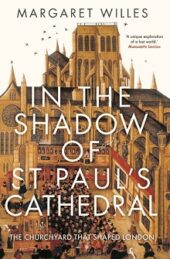Margaret Willes, what inspired you to write about this subject, a book not about the cathedral, but about its surrounding area?

16th century St. Paul’s
My first memory of St Paul’s Churchyard was emerging from the Underground into an area of devastation. It was probably in 1953, when my father took me up to London as he planned to take photographs of the City churches, to be lit up for the coronation of Elizabeth II. The Blitz had flattened the buildings of the Churchyard and Paternoster Row, for centuries the heart of the English book world. As I spent my subsequent career in book publishing, I became intrigued by the area and resolved to trace its history.
St. Paul’s is such an iconic building today, but was it always viewed with reverence by those that lived in its shadow?
The massive cathedral built by the Normans dominated medieval London, and those that lived around it treated with a mixture of reverence and familiarity, often referring to it just as ‘Paules’. With the Reformation the nave became very much a secular space, with people promenading, exchanging the latest news and showing off the latest fashions.A public thoroughfare crossed from north to south, with carts and animals transporting goods even when divine service was celebrated in the choir behind the great screen.
Your book describes the vibrancy among those who went about their lives in the grounds of St. Paul’s. Was it the centre of London during this time?
I think of St Paul’s Churchyard, with its central position, as a hinge, between the financial and civic centre around the Guildhall, and the road leading westwards down Ludgate Hill to Fleet Street, the Strand and Westminster, the seat of the royal court and of parliament.
Thomas Carlyle described Paul’s Cross as The Times newspaper for the nation. Why was that?
In the north-east corner of St Paul’s Churchyard a cross and an open air pulpit was established in the 13th, and possibly the 12th century. Here sermons were preached but also notices were given and proclamations made. Thomas Carlyle, the Victorian writer, described it as being the equivalent of The Times newspaper.
What were the different trades a visitor could find in the courtyard of St. Paul’s in the 18th century?
The combination of pulpit and press was a natural one, with sermons and other religious works published by the Churchyard booksellers, but a wide range of publications were on offer, including prints and newsbooks. The other dominant trade was of textiles, the staple of the English economy. Samuel Pepys describes in his diary shopping in Paternoster Row for clothes and for furnishings. But there was a huge variety of shops offering, for example, furniture, spectacles and scientific instruments, and exotic foods in premises often described as Italian warehouses. These were all high end establishments, on a par with today’s Bond Street or Knightsbridge.
Dolly’s Chophouse seems like quite the place to visit. Who would we have bumped into if we’d frequented the place in the late 17th and 18th centuries?

In the 18th century the Churchyard was a highly convivial place for those who could afford luxuries. There were taverns and coffee houses where men – and it was only men – could go to enjoy discussing the issues of the day, with food and drink on offer. Sometimes the gatherings were strictly business, such as those held to auction valuable copyrights at the Chapter Coffee House. Sometimes they were political, although I’m not sure that the Club of Honest Whigs really took this seriously. Dr Johnson, was a member of that club, along with several others, including what sounds a fun establishment, Dolly’s Chop House in Queen’s Head Passage, just to the north of Paternoster Row. Here the Doctor met up with fellow writers, clergymen and publishers to eat beefsteak and ale served by attractive waitresses.
The Luftwaffe carried out a major redesign in 1940 – why did publishing not return to the area as it had after the Great Fire?
As my visit in 1953 shows, it took years for the area around St Paul’s to be rebuilt, and the many publishers who had occupied premises in Paternoster Row found locations elsewhere, in particular joining the houses that had been established in Bloomsbury. The area to the south of St Paul’s Cathedral had been less badly damaged, so that Routledge & Kegan Paul continued to reside in Carter Lane until driven out in 1976 by sharply rising rental rather than bombs.
Is there anywhere in London similar to the area today?
Today the publishing industry is even more scattered, often with offices outside London altogether. However, there is one publishing enclave still in Bloomsbury. My own publisher, Yale University Press, has their British office in Bedford Square, along with Bloomsbury and Maggs, the antiquarian booksellers, but this is exceptional. The Churchyard is no longer synonymous with booksellers just as Fleet Street has lost its many newspaper offices.
Nowadays the recent development of the rather sparse Paternoster Square makes up much of the area round St Paul’s, and publishing has been replaced by investment banking. What do you make of it, and what do you think some of the characters in your book would think?
I find the area around St Paul’s Churchyard today rather sterile. Here and there there are some fascinating buildings; the cathedral itself, of course, Stationers’ Hall still in Ave Maria Lane, the exotic Victorian choir school in Carter Lane that now houses the homeless. Not forgetting the Temple Bar, the former entrance to the City in the Strand which now forms part of the quadrangle that is Paternoster Square. I think my feelings would be shared by those old booksellers who enjoyed the close proximity of the like-minded – and of those who held violent opposed views.
Margaret Willes is the author of In the Shadow of St Paul’s Cathedral, published by Yale University Press.







